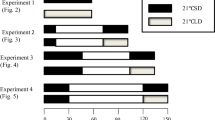Summary
When exposed to continuous darkness at a temperature of 20°C, the mean annual temperature in its biotope, Broscus laevigatus Dej. needs nearly 1 year for its complete development. 7–8 of this are needed for the maturation of the gonads.
Continuous darkness combined with a temperature of 30°C delays the maturation of the gonads whereas it is accelerated if this exposure to 30°C is followed by exposure to 20°C.
A period of long days with 14/10h-L/D retards the development of the gonads in B. laevigatus. If a period of long days is followed by one of short days with 10/14h-L/D maturation of the gonads is accelerated.
Middle European photoperiods have a stronger influence on the development of the gonads than the North African photoperiods.
The propagation rhythm of this North African carabid beetl shows marked relations to Middle-European species characterized by autumn propagation and aestivation.
Zusammenfassung
Im Dauerdunkel bei einer konstanten Temperatur von 20°C, der mittleren Jahrestemperatur in seinem Lebensraum, benötigt B. laevigatus für seine gesamte Entwicklung ungefähr 1 Jahr. Auf die Gonadenreifung entfallen davon 7–8 Monate.
30°C im Dauerdunkel hemmen die Gonadenentwicklung dieser Art. Temperatursenkung auf 20°C, die auf eine Behandlung mit 30°C folgt, bewirkt einen beschleunigten Abschluß der Gonadenreifung.
Langtag von 14/10 h-L/D hemmt die Gonadenentwicklung von B. laevigatus. Folgt Kurztag von 10/14 h-L/D auf den o. g. Langtag, so wird die Gonadenreifung ebenfalls beschleunigt abgeschlossen.
Die in Mitteleuropa herrschenden Tageslängen beeinflussen die Gonadenentwicklung stärker als nordafrikanische Photoperioden.
Die Geschlechter reagierten unte allen Versuchsbedingungen gleich.
In der Steuerung seiner Fortpflanzungsrhythmik zeigt dieser nordafrikanische Carabide starke Beziehungen zu mitteleuropäischen Arten mit Herbstfortpflanzung und Sommerruhe.
Similar content being viewed by others
Literatur
Junk, W., Schenkling, S.: Coleopterorum Catalogus, Bd. I, Carabidae I, Horn, W., Carabidae: Cicindelinae, 345 S. Berlin: 1926; Csiki, E., Carabidae: Carabinae I. Berlin: 1927, Bd. II, Carabidae II, Csiki, E., Carabinae II, Mormolycinae, Harpalinae I, S. 1–1022. Berlin: 1928–1931. Bd. III, Carabidae III, Csiki, E., Harpalinae II, S. 1023–1933. Berlin: 1932–1933
Krehan, I.: Die Steuerung von Jahresrhythmik und Diapause bei Larval-und Imagoüberwinterern der Gattung Pterostichus (Col., Carab.). Oecologia (Berl.) 6, 58–105 (1970)
Paarmann, W.: Untersuchungen über die Jahresrhythmik von Laufkäfern (Coleoptera, Carabidae) in der Cyrenaika (Libyen, Nordafrika). Oecologia (Berl.) 5, 325–333 (1970)
Paarmann, W.: Bedeutung der Larvenstadien für die Fortpflanzungsrhythmik der Laufkäfer Broscus laevigatus Dej. und Orthomus atlanticus Fairm. (Col., Carab.) aus Nordafrika. Oecologia (Berl.) 13, 81–92 (1973)
Thiele, H. U.: Formen der Diapausesteuerung bei Carabiden. Zool. Anz., Suppl. 31 (Verh. Dtsch. Zool. Ges. 1967), 358–364 (1968)
Thiele, H. U.: The control of larval hibernation and of adult aestivation in the carabid beetles Nebria brevicollis F. and Patrobus atrorufus Stroem. Oecologia (Berl.) 2, 347–361 (1969)
Thiele, H. U.: Die Steuerung der Jahresrhythmik von Carabiden durch exogene und endogene Faktoren. Zool. Jb. Abt. System, Ökol. u. Geogr. 98, 341–371 (1971)
Walter, H., Lieth, H.: Klimadiagramm Weltatlas. Jena: Gustav Fischer 1960
Author information
Authors and Affiliations
Additional information
Die Untersuchungen wurden von der Deutschen Forschungsgemeinschaft unterstützt.
Rights and permissions
About this article
Cite this article
Paarmann, W. Der Einfluß von Temperatur und Lichtwechsel auf die Gonadenreifung des Laufkäfers Broscus laevigatus Dej. (Col., Carab.) aus Nordafrika. Oecologia 15, 87–92 (1974). https://doi.org/10.1007/BF00345230
Received:
Issue Date:
DOI: https://doi.org/10.1007/BF00345230




